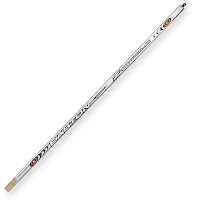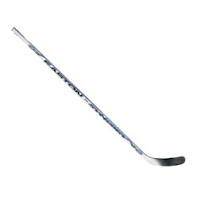Archive for the mac daddy Category
Choose your weapon part 2; How and why composite sticks conquered hockey
So, where was I? Wood sticks…aluminum shaft…Z-Bubble…OK, got it. So we reviewed where composite sticks came from now let’s talk about why they work, what’s important in selecting a composite stick that is right for you
Probably the most common question I get asked about composite sticks is what’s the most important feature when selecting a stick. When I first started in this business and wood sticks were the norm I’d tell you the order of features ranked by importance was lie, curve, flex. For composite, while I’d actually list lie as #2, it tends to go flex, curve, lie, well, in reality for most younger players it goes curve, curve, curve but I digress. Texture and weight are 2 other elements to consider but far less important in the overall scheme of things. Let’s talk about flex, lie, and curve.
Selecting the proper flex of a composite stick is probably most important. The design of the original Easton Synergy was developed with the the physics of the swing of a golf club in mind. What this meant was that the bottom of the stick should flex enough that at the top of the swing the head, or in this case the blade, should flex back well behind the shaft and your hands. When the direction is reversed and the blade catches up to the shaft the result is catapult like creating a low, hard shot. So, basically stated, a stick that is too stiff will eliminate this explosiveness. Yes, on the other hand a stick too “whippy” loses some accuracy but your really buying a composite stick for the velocity benefit so much better to err on the side of too flexible. Most sticks are rated on the original Easton scale of 85, 100, 110 flex. At it’s basest explanation, think of it as pounds per square inch. An 85 flex would take approximately 85 pounds of pressure to bend one inch etc. For our purposes the scale is simply a standard measure with 85 being more flexible then 100 etc. So, now that you’ve decided on the flex there is one more curve ball; cutting the stick to height. Every 2 inches you cut a stick will increase the relative stiffness of the stick. It is MOST important to keep this in mind before your final decision is made. Decide and what would be your ideal flex then choose the stick that, when cut to you ideal height, achieves that flex. It’s not as confusing as it may sound but as always you can consult with your local hockey shop pro.
The lie of the blade and by extension the stick itself is every important. It is literally how the blade “lies” on the ice. Simple, right? Well, back when blade heels were less rounded it was maybe the most singular element of importance in your stick. It affected your stance, the way the blade struck the puck, and whether or not you’d find pucks sneaking under your blade. As the heels and bottoms of the blades became more and more rockered the importance of lie became lost in the shuffle to the point until recent years the lie was not even printed on most composite sticks at all. Advice here? Grab a stick, figure where you would cut it, hold it like you would at that cut height, stand in a ready position and see how much “daylight” is under your blade then adjust accordingly. One problem is that typically, each curve pattern come in only one lie so you will have to weight that decision which leads us to…
Curve patterns. Quite literally this is the size and position of the curve on any given blade. position is usually named as heel, mid, or toe curve. Each position has it’s advantages and drawbacks. The curve size runs from diminutive to maximum legal size (about 3/4″) with each having it’s own set of pluses and minuses. So how do you choose? Well, typically in the States the slighter mid or heel curve reins supreme (Forsberg, Modano). My theory is that a “vanilla ice cream” curve involves a lot less risk at the high price of most stick and so they are most popular. Most pros tend towards a severe heel wedge which strikes the puck in a similar fashion to a sand wedge in golf and provides a hard accurate shot. However as there is little actual “curve” only a really skilled player can get a great wrister or pass with this kind of curve. Bottom line is simply go with what you’re comfortable with or the right balance between curve and lie (see above) that works for you.
OK, this has run on a bit but the gist of it is whether it’s a Synergy SE, RBK 9K, or Nike Bauer ONE90, whether the lightest or most durable, grip or no grip start by making sure the flex, lie, and curve are what’s right for you and the rest will fall into place.
When next we meet we’ll discuss popular myths and misconceptions and are composite sticks really worth the money. Until then may all your shots be on net!
Choose your weapon part 1; How and why composite sticks conquered hockey
Unless you playing days ended before the Great One skated his last lap around the ice then you know buying a hockey stick is no longer a simple process. With traditional wood sticks all but forgotten at the upper levels of the game we are officially in the composite stick age. With prices about to max out at around $250 for the highly anticipated RBK 9K sticks, not skates, have become the most expensive part of the game. So, how did we get here and what should you consider when purchasing a composite hockey stick? This week I’ll talk about the genesis and then we’ll talk about the good, the bad, and the ugly of purchasing a composite stick.
So, how did wood sticks end up becoming nearly extinct? Well, there are a few reasons including but not limited to the price of lumber. The average performance wood stick had jumped to over $20 and most closer to $30. Mostly it was an issue of consistency that led the revolution. The limitation of wood sticks at the highest level was you couldn’t control such variables as knots, dryness, and general quality of the raw ingredients from one stick to another. Another issue became players needing a stiffer flex often had to suffer through a stick that was heavier then desired. The first step towards composite was aluminum. If you played any time from the 80’s to mid 90’s you likely remember the aluminum shaft. This was great in that is was much lighter and consistent…well, unless it bent. Which they did. A lot. Trying to shoot straight with a bent stick is never a great idea. The n ext step was the composite shaft. The earliest versions were made through a process call pultrusion mostly used in the manufacture of boat masts. While this solved the problem of bowing and bending they had no play and were heavy. To me the stick that really changed the game was the Easton Z-Bubble shaft. The Z-Bubble incorporated a lot of golf club technology into the design figuring the swing of a club and a stick were pretty similar. What made this different was the taper at the bottom of the shaft. THIS was revolutionary. This created what was know as a focus flex region or, basically stated, an area of the stick that flexed back further and easier then the rest of the shaft keeping the head or blade behind the hands longer as well as explosive follow through. It was almost perfect except they had to deal within the boundaries of replacement blades with a square peg so they couldn’t mess with the geometry of the shaft itself too much (I know someone will mention the T-Flex shaft and blades which were really the true next step to the full composite stick but as it was generally considered a failure we’ll just skip over it). But change was just around the corner.
ext step was the composite shaft. The earliest versions were made through a process call pultrusion mostly used in the manufacture of boat masts. While this solved the problem of bowing and bending they had no play and were heavy. To me the stick that really changed the game was the Easton Z-Bubble shaft. The Z-Bubble incorporated a lot of golf club technology into the design figuring the swing of a club and a stick were pretty similar. What made this different was the taper at the bottom of the shaft. THIS was revolutionary. This created what was know as a focus flex region or, basically stated, an area of the stick that flexed back further and easier then the rest of the shaft keeping the head or blade behind the hands longer as well as explosive follow through. It was almost perfect except they had to deal within the boundaries of replacement blades with a square peg so they couldn’t mess with the geometry of the shaft itself too much (I know someone will mention the T-Flex shaft and blades which were really the true next step to the full composite stick but as it was generally considered a failure we’ll just skip over it). But change was just around the corner.
The full composite stick was the unicorn of the hockey world for several years. A lot of people will lay claim to the first full composite stick (my earliest recollection was a company called Busch which partnered up with everyone from Sherwood to Itech to get their product out there) but the hockey world simply wasn’t ready for a $200 stick. So, it was Easton, the leader in composite shafts and blades that finally broke through and quite by accident if you believe the stories. Stuck with the problem of showing around a prototype of a 1-piece composite stick that would retail at $ 150, taking pre-orders, then not being able to produce the stick for a price that would make this price a reality. So, they went back to what was one of their biggest failures…yup, the T-Flex (see, you knew I mentioned it before for a reason). The end result was what has become known as a fused 1-piece stick. Basically taking a composite shaft with an ultra-long taper ending in an extremely narrow opening inserting a composite blade with a much shorter, much narrower peg and permanently bonding them together. Yes, this was the birth of the original Synergy. Now, to say it was an overnight success would be lying as sticker shock was still in affect. However, with improved looks, increased usage at the highest levels, and tremendous positive feedback, the revolution had truly begun.
150, taking pre-orders, then not being able to produce the stick for a price that would make this price a reality. So, they went back to what was one of their biggest failures…yup, the T-Flex (see, you knew I mentioned it before for a reason). The end result was what has become known as a fused 1-piece stick. Basically taking a composite shaft with an ultra-long taper ending in an extremely narrow opening inserting a composite blade with a much shorter, much narrower peg and permanently bonding them together. Yes, this was the birth of the original Synergy. Now, to say it was an overnight success would be lying as sticker shock was still in affect. However, with improved looks, increased usage at the highest levels, and tremendous positive feedback, the revolution had truly begun.
Today there are hundreds of composite sticks on the market claiming different manufacturing processes, lightest weight, most durable etc. Several companies have even perfected the “true 1-piece” stick (not fused). But, nearly a decade later, the “mistake” Easton made in it’s latest incarnation as the Synergy Elite remains the most popular and best known composite stick in hockey








 Location:
Location:  Phone:
Phone:  Email: info@sportsetc.net
Email: info@sportsetc.net